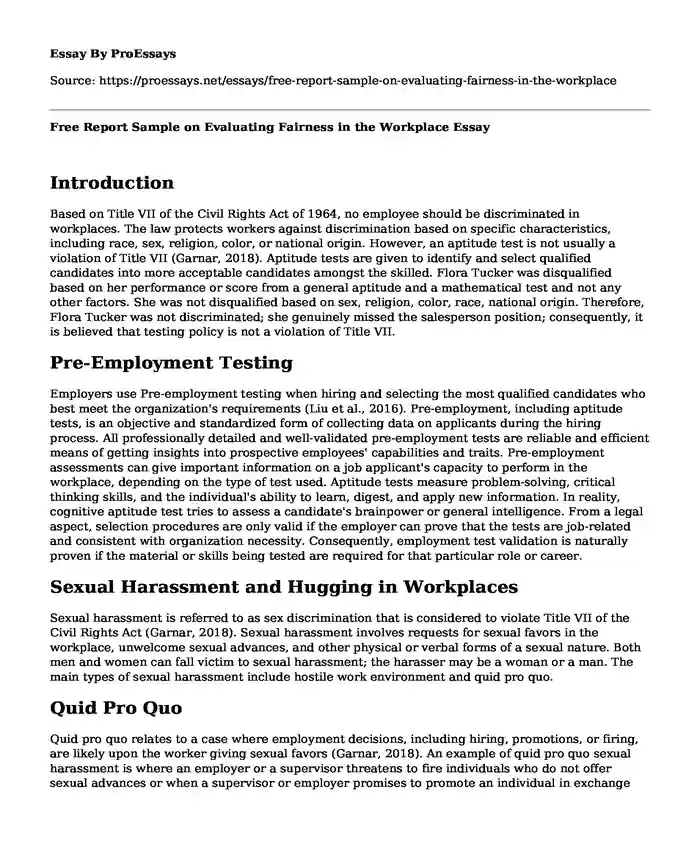Introduction
Based on Title VII of the Civil Rights Act of 1964, no employee should be discriminated in workplaces. The law protects workers against discrimination based on specific characteristics, including race, sex, religion, color, or national origin. However, an aptitude test is not usually a violation of Title VII (Garnar, 2018). Aptitude tests are given to identify and select qualified candidates into more acceptable candidates amongst the skilled. Flora Tucker was disqualified based on her performance or score from a general aptitude and a mathematical test and not any other factors. She was not disqualified based on sex, religion, color, race, national origin. Therefore, Flora Tucker was not discriminated; she genuinely missed the salesperson position; consequently, it is believed that testing policy is not a violation of Title VII.
Pre-Employment Testing
Employers use Pre-employment testing when hiring and selecting the most qualified candidates who best meet the organization's requirements (Liu et al., 2016). Pre-employment, including aptitude tests, is an objective and standardized form of collecting data on applicants during the hiring process. All professionally detailed and well-validated pre-employment tests are reliable and efficient means of getting insights into prospective employees' capabilities and traits. Pre-employment assessments can give important information on a job applicant's capacity to perform in the workplace, depending on the type of test used. Aptitude tests measure problem-solving, critical thinking skills, and the individual's ability to learn, digest, and apply new information. In reality, cognitive aptitude test tries to assess a candidate's brainpower or general intelligence. From a legal aspect, selection procedures are only valid if the employer can prove that the tests are job-related and consistent with organization necessity. Consequently, employment test validation is naturally proven if the material or skills being tested are required for that particular role or career.
Sexual Harassment and Hugging in Workplaces
Sexual harassment is referred to as sex discrimination that is considered to violate Title VII of the Civil Rights Act (Garnar, 2018). Sexual harassment involves requests for sexual favors in the workplace, unwelcome sexual advances, and other physical or verbal forms of a sexual nature. Both men and women can fall victim to sexual harassment; the harasser may be a woman or a man. The main types of sexual harassment include hostile work environment and quid pro quo.
Quid Pro Quo
Quid pro quo relates to a case where employment decisions, including hiring, promotions, or firing, are likely upon the worker giving sexual favors (Garnar, 2018). An example of quid pro quo sexual harassment is where an employer or a supervisor threatens to fire individuals who do not offer sexual advances or when a supervisor or employer promises to promote an individual in exchange for sexual favors (Liu et al., 2016).
Hostile Work Environment
This type of sexual harassment relates to states where the employee’s workplace or environment is made hostile, offensive, or intimidating due to undesirable sexual conduct, and when such conducts unreasonably interfere with their work performance (Garnar, 2018). Such harassment could include unwanted sexual advances from their fellow employee. Other examples may involve displaying sexually-oriented cartoons or photos, making offensive sexual jokes or comments, and discussions about sex (Liu et al., 2016).
Conclusion
In a case where the boss likes hugging employees in for a job well done, it is not sexual harassment if the employees are happy with it; however, if the employees do not want it, then it is sexual harassment (Roscigno, 2019). The Equal Employment Opportunity Commission (EEOC) reveals that hugging actions can be considered sexual harassment when they are severe or so frequent that it creates an offensive or hostile work environment. Hugging can be regarded as sexual harassment if there are sexual innuendos, where the recipients do not want to be touched or when the hug is improper for work.
References
Garnar, T. L. (2018). Differential enforcement of Title VII of the Civil Rights Act of 1964 with respect to sex discrimination.
https://tigerprints.clemson.edu/all_theses/3140/
Liu, C., Macgill, E., & Vora, A. (2016). Sex discrimination claims under Title VII of the Civil Rights Act of 1964. Geo. J. Gender & L., 17, 411.
https://heinonline.org/HOL/LandingPage?handle=hein.journals/grggenl17&div=18&id=&page
Roscigno, V. J. (2019). Discrimination, sexual harassment, and the impact of workplace power. Socius. https://doi.org/10.1177/2378023119853894.
Cite this page
Free Report Sample on Evaluating Fairness in the Workplace. (2023, Nov 16). Retrieved from https://proessays.net/essays/free-report-sample-on-evaluating-fairness-in-the-workplace
If you are the original author of this essay and no longer wish to have it published on the ProEssays website, please click below to request its removal:
- Essay Sample on Refugees and Immigrant in the U.S
- Classification of Types of Bosses and Supervisors
- Age-Related Effects and Medical Conditions That Affect Driving in Older Adults
- The International Organizations in Asia as a Sources of Stability Essay
- Essay Sample on Vulnerable Populations: Challenges & Social Factors
- Essay Example on Wealth Inequality in Canada: The Growing Divide
- Essay Example on African Americans' Struggle for Equality Post WWII







